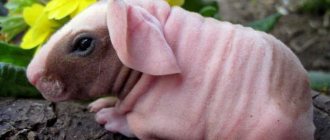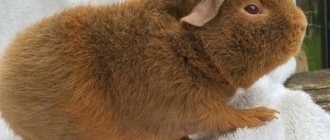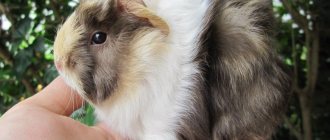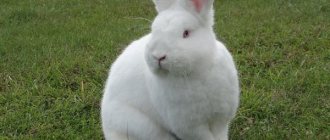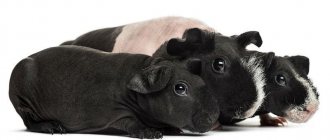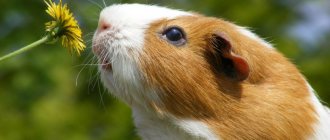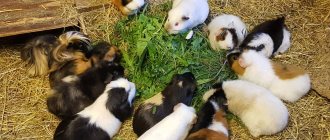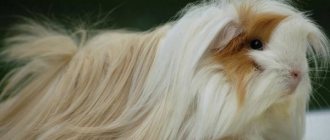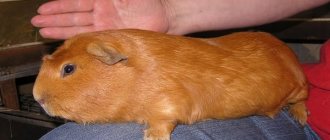- home
- Guinea pig
- Guinea pig breeds
01/26/2019 A cute and affectionate skinny guinea pig brings comfort to the home atmosphere. She has a friendly character and minimal care for the hairless rodent. It is enough to provide the pig with conditions suitable for its body.
Origin
The idea of breeding hairless breeds of guinea pigs has been nurtured since the moment the first hairless mutant pig, which had a malfunction in its genes, was born. This happened in 1978 at the Armand Frapper Institute in Canada. After another 6 years, a similar story repeated itself. And scientists began to work closely on breeding pigs with extraordinary external characteristics. The first female was “skin and bones”, so she was nicknamed Skinny. So this name was officially assigned to the breed.
Hairless pigs did not leave the laboratory for a long time and were used for research in the field of dermatology. They had a very vulnerable immune system, which did not allow rodents to survive in home cage conditions. As a result, the skinnies were crossed with selfies, which strengthened the animal’s immunity at the genetic level.
Currently, every two generations of skinnies it is recommended to “renew the blood” by crossing with selfies. Only in this way can the vitality of the delicate animal be maintained.
Owner reviews
Naturally, high-end guinea pigs are inaccessible to ordinary buyers. In any case, if you plan to breed them, you should opt for purebred specimens.
Interesting to know! In our country, guinea pig breeding has not yet reached such a high level as abroad. Despite this, true connoisseurs of these animals try to acquire individuals that have an attractive and exotic appearance.
It should also be remembered that you cannot cross long-haired and short-haired representatives of the breeds, since the result will be offspring that are low-quality mestizos and no one will allow them to be shown at exhibitions. On top of that, crossing different breeds is also unacceptable because it hinders the improvement of the breed data of any of the species.
Guinea pigs have earned the right to be considered one of the most sought-after pets. Ease of care and maintenance is acceptable for everyone, even novice owners. This is an affectionate and sociable animal that is perfect for families with children.
Breed standards
Skinny is a very expensive and rare breed of pig. Once upon a time, the price was so high that only wealthy families bought animals.
Breed standards, in force since 2008, provide for a certain shape of the head, eyes and ears, features of the external coat and other parameters:
- developed muscles;
- harmonious body proportions;
- wide chest;
- the bridge of the nose is slightly curved;
- large shiny eyes;
- ears are flat;
- the fur on the nose is hard and does not grow beyond the eyes;
- Pleasant to the touch leather with folds.
When choosing an animal, you need to carefully examine the skin, which should be free of wounds and bruises.
Skinnies are plump, but within reasonable limits. You can't call it obesity.
Appearance
Since skinnies have no hair, they are sometimes called "sphinxes" by analogy with the breed of hairless cats.
But if you take a closer look and stroke the animal, you can feel that the skin is not bald. Very short, silky fur is present. Thanks to this feature, the skinny feels very pleasant to the touch. Small amounts of fur are visible near the nose and on the paws.
Adults reach a length of 35 cm, height at the withers is 6.8 cm. Males are larger than females. The animal weighs one and a half kilograms or more.
The body can be smooth, but more often with folds. Eyes with a lively sparkle, expressive and large.
Pigs can be of different colors. There are brown, gray, beige, spotted. A great rarity is the black skinny, which looks very elegant.
Conditions of detention
The pig cares what kind of housing it will have and where it will be located. To make the cage easier to wash, it is better to have metal bars and a plastic tray. The minimum area per animal is 0.6-0.7 square meters. m. A rectangular cage is better than a square one, so that skinny can run around. The best option is to install a stationary enclosure nearby, where the animal can play and run around.
The bottom of the cage should be covered with a 1.5 cm layer of sawdust, which is changed regularly. Floor grates are excluded. A well-fed pig will break its legs on the first day.
The cage is equipped with two feeders (for rough and succulent feed), a hay box, and an automatic drinker. The house chosen is low, up to 10 cm, with a flat roof. A skinny guinea pig can not only relax and retire in it, but also use it as an observation post. For convenience, a ramp is provided.
You should not use an aquarium or a dune as housing for a skinny. Despite the fact that it is warmer there, air exchange is difficult. This negative factor will shorten the animal’s life. It is enough to maintain +24 ℃ in the room, do not place the cage in a draft, near a door or window.
The hairless animal loves to climb into warm fabric sleeping bags and explore tunnels and labyrinths. They can be made from cardboard boxes and fabric, or bought ready-made.
Breeding quality
There is such a thing as “breeding quality.” It concerns breeds and specific individuals intended for exhibitions. Conventionally divided into 3 classes:
- Show class - maximum compliance with the breed standard. Purebred representatives of the species. How much such a guinea pig costs depends on the severity of the breed of each individual. In most cases, it is this class that wins at exhibitions. The cost is very high, since few people agree to sell them. It takes a lot of effort and time to raise a purebred animal.
- Breed class - there is a slight deviation from accepted standards. Changes may be expressed in color or other features. Not suitable for exhibitions, but capable of producing show class offspring. Used for breeding.
- Pet class - a completely healthy individual, but with congenital or acquired defects. Not intended for exhibitions or breeding. Usually bought as a pet.
If you need an animal for an exhibition, the cost greatly depends on the class. In general, a guinea pig can cost from 500 to 5 thousand rubles or more.
Nutrition
To maintain your skinny pig's immunity, it needs to be fed a balanced diet. The diet should include fresh hay from cereal crops, grains, vegetables, fruits, and herbs.
Basic feeding rules:
- The haybox is filled with fresh hay. Additionally, branches of fruit trees and shrubs are placed to grind down the teeth.
- Roughage should consist of a variety of grains and prepared grass pellets. The animal needs 3 tablespoons of grain per day.
- Fruits and vegetables in the daily diet include pumpkin, carrots, apples, lettuce, parsley and sweet bell peppers. Feed is alternated and added as it is eaten.
- The animal needs to drink a glass of water per day. A solution of vitamin C is added to the water two or three times a week.
- As a treat, the animal is offered low-fat dry cookies, unsweetened crackers, nuts, and dried fruits.
The rodent will like liquid cereal porridge cooked in water.
You should not give your animal chocolate, potatoes, eggplants, hot peppers, avocados, garlic, radishes, radishes, or mushrooms.
Optimal weight and walking
A skinny pig needs 2 times more food than rodents that have fur. Food helps maintain the desired weight and provides energy so that the animal does not freeze.
Obesity is just as dangerous for skinnies as exhaustion. Therefore, the rodent is provided with the opportunity to spend its life in motion, walking and playing.
The cage must be a meter long. An enclosure is set up near the home or a walking area in the room is fenced off so that the rodent cannot get into hard-to-reach places.
Skinnies can only be walked in the fresh air in the summer. At temperatures below +22–24 ℃ the pig freezes.
Social structure and reproduction
Photo: Skinny pigs
The first skinnies were bred by scientists. When the hairless mutation was discovered, they decided it would be very useful to develop it. Hairless guinea pigs could be used more conveniently for research purposes. They can avoid the stress of shaving and have quick access to their skin. But it wasn't easy.
The first breed bred was not healthy. In fact, they were very sick indeed. In addition to this, scientists also had difficulty getting females to become pregnant and were unable to successfully mate them with each other. Most importantly, there were serious problems with their life expectancy, since they were immunocompromised.
Unable to fight off normal infections, they died young, even if they were weaned off milk. Scientists had to do hard work to bring these early skinnies to an adequate level of health. However, with careful breeding they were able to create the skinnies as they are known today.
Breeding is one of the most exciting things to know about skinnies. Breeding these guinea pigs must be done with care. The hairlessness gene is recessive. This means that both parents must carry it to be able to pass it on to their children.
So, if you mate two skinnies together, all the children will be hairless. But if you breed a hairy guinea pig without hair, then the babies may be hairy or hairless. Again, when you breed two hairy guinea pigs together that both carry this gene, there is a chance that the children will become hairless skinnies. However, most hairy guinea pigs do not carry this gene unless they are part of a skinny breeding program.
Fun fact: There are several varieties of hairless guinea pigs, and not all of their genes are the same. For example, one species, the Baldwin's guinea pig, which is completely hairless, has its hairlessness caused by a different gene. Thus, a Baldwin crossed with a skinny will produce hairy children.
Behavior
Skinnies do not conflict with other pets. They are emotionally sensitive, quickly become attached to kittens, birds, puppies, and try to cuddle with them. They seek affection from their owners. They can sit on their knees for a long time. They love it when a warm hand is placed on their back.
The rodent does not bite, is very inquisitive and active.
If the animal is healthy and well-fed, it is not dangerous for small children.
Pigs are chosen as gifts for children as the most socialized and contactable pets.
The beauty of guinea pigs
According to many owners, the small guinea pig is practically devoid of shortcomings as such, although this animal is not for everyone. The main advantages include:
- Complete absence of aggression;
- Peace of mind at any time;
- Doesn't need a big house;
- Unpretentious;
- Doesn't bite;
- With proper care it does not leave odors;
- It is easily tamed and loves human affection and attention.
They reproduce easily, which breeders do not neglect. Guinea pigs are primarily kept as pets, but are also used for food. To date, more than 50 different breeds have been bred, each of which can be purchased. Due to the popularity of guinea pigs, owners hold many exhibitions and even seminars. Animals are ready to reproduce already in the second month of life. Thanks to their special friendliness, children love them very much.
Skinny care
Caring for a hairless breed is made easier by the fact that the pig does not need to be constantly brushed; it does not shed. To prevent the pig from scratching its delicate body, you should not leave objects in the cage that could injure the animal.
You should trim your rodent's nails regularly. Otherwise, there is a danger that the animal will scratch itself. Since Skinny's immunity is low, the wound will take a long time to heal.
Every three to four weeks, the animal’s ears are carefully cleaned and the eyes are washed with clean boiled water using a cotton swab.
Skinnies should only be bathed as a last resort if there is severe contamination. To maintain cleanliness, the animal is regularly wiped with a damp cloth.
Flavorings, alcohol solutions, detergents and disinfectants cannot be used to wipe the pig.
Distinctive features of hairless breeds
Hairless sea pets have some characteristics that you should know about before purchasing such pets.
Pets' sensitive skin is susceptible to exposure to sunlight. This means that the pet’s home cannot be placed on the sunny side, otherwise the pet may get burned.
The temperature in the room where the hairless animal is kept should be maintained at 22 degrees. The normal body temperature of an animal is 38–39 degrees.
Feeding these rodents must be more frequent due to their accelerated metabolism. Therefore, keeping a hairless guinea pig is more expensive.
Some people are allergic to wool and do not have pets. The exception is hairless animals.
The life expectancy of representatives of hairless breeds is longer, it ranges from 5 to 9 years.
Invisible dangers
A guinea pig faces dangers that the owner may not even suspect. Despite the fact that skinny looks well-fed and strong, she can easily damage her internal organs and limbs if she falls even from a small height.
With a lot of weight, there is a lot of stress on the paws. The diet must contain food high in phosphorus and calcium, otherwise the pig’s paws may become crooked. Cereals such as oats, barley and corn are sources of phosphorus for rodents. The pig is given mineral stones containing calcium (chalk).
A hairless animal is absolutely helpless in the cold. The slightest draft will quickly catch a cold. Even if you sew clothes for the animal, you cannot go outside with the animal in the cool season.
Character and lifestyle of skinny pig
Hairless skinny pigs are super social animals, very good-natured and affectionate. Very inquisitive, they can sit for hours opposite the hostess who is preparing dinner, watching her actions and with a “smile” across her face, accepting from her hands with her paws everything that this hostess gives in a fit of emotion, and, of course, immediately eating them.
If there is a cat in the house, the skinny guinea pig can be found curled up under its warm side and peacefully dreaming to the vibrating purr of the cat. Naked animals just as easily and quickly find a common language with dogs, fish and any other animals.
As for lifestyle, keeping skinny guinea pigs is also convenient because the animals quickly adapt to the rhythm and regime in which people live.
If a person sleeps during the day and works at night, for example, at the computer, then the pet will do the same. The only thing that is necessary is to take the animal out of the terrarium when returning home.
If a pig sees an owner who has come and ignores her joyful greetings, she may become upset and get sick, however, sometimes in such situations a heart break occurs, “from grief.” Therefore, quite often these animals are kept in groups of 2-4 individuals, so that they do not get bored alone.
Skinny Breeding
Breeding skinny pigs is possible if you provide the female and male with comfortable living conditions and proper nutrition. When the female is six months old, she is ready to become a mother and feed her cubs. Males are considered sexually mature at 3 months. But you should wait until they are seven months old to mate.
The diet of animals before mating includes nuts and sunflower seeds. Particular attention is paid to daily walks to ensure that the pigs remain in good physical shape.
The female carries the cubs for about 70 days. All this time, she is carefully protected from stress factors and adequate feeding is organized.
Angora guinea pig - how much does it cost?
One of the most common breeds is the Angora; in a pet store such a pig costs 1000–2000 rubles. The price depends very much on the region. If the owner sells the animal, you can take it for 500–1000 rubles.
The cost of guinea pigs depends on age. When purchasing, pay special attention to this factor. If the price is too low, the animal may be elderly or sick. The Angora guinea pig has gained such high popularity due to its attractive long fur.
